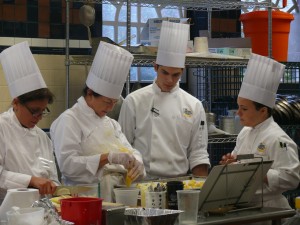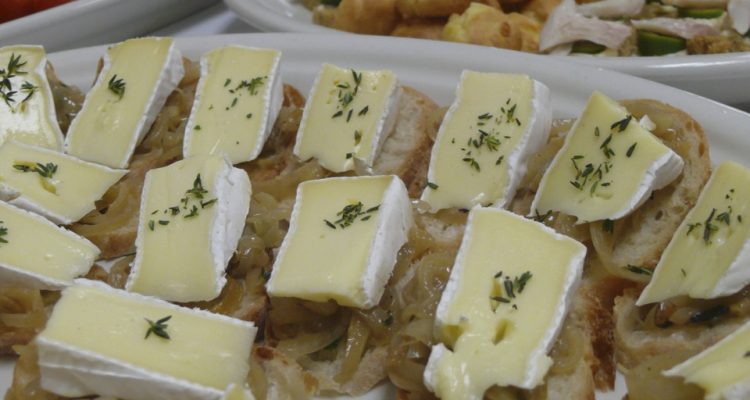No, not that CIA—the other one, in Hyde Park, New York: the Culinary Institute of America.
I’m an experienced cook. I’ve done my 10,000 hours in the kitchen, maybe even 10,000 hours chopping onions. I know about mise en place. I know how to mince a shallot. I have decent knife skills and can keep them sharp, too. I cook without recipes 99% of the time and nobody’s died yet.
I love to cook and love to learn, but I have no professional training. And so, when I got a cold call last summer from the CIA, inviting me to take on one of their Boot Camps, gratis, I pounced.
Boot Camps. They are two- to five-day culinary immersion (blenders) held at the CIA campuses in Hyde Park, New York, St. Helena, Calif., and San Antonio, Texas. Topics range from bistro fare to Asian cuisine, comfort food to grilling. The St. Helena campus offers wine-related camps, too, on things like wine tasting, wine and food pairing, and wine country cuisine.
The camps aren’t for credit, because they’re not aimed at professionals; they’re aimed at enthusiastic amateur cooks like me who want to experience professional-grade training. Instructors are often the same faculty who teach the undergraduate culinary students, and the training regimen is billed as a rigorous all-day affair.
Of course as a wine writer, I was drawn to the wine-related camps. But California is a schlep for me, so I chose the two-day Hors d’Oeuvres Boot Camp in Hyde Park. I figured there’d be some discussion of wine, because nobody eats hors d’oeuvres without wine, at least not at my house. I recruited a friend to join me, one of the best cooks I know. She’d contemplated attending culinary school as a kid, and had been hankering to take a CIA course for years.
We were instructed to muster for our Boot Camp orientation at 6 a.m., so we headed over a day early, checking into a well-appointed suite at the exceptionally convenient Residence Inn in Poughkeepsie. The inn’s just a few miles down the road from the Hyde Park campus, and our suite included a kitchen and sitting area, plus two lovely bedrooms into which, fatigued from all-day-on-our-feet travail, we could gratefully, privately, collapse.
On the first day of our camp, we rose at 5:15, and by 5:45 were wending our way toward Roth Hall, the impressive, colonnaded centerpiece of the school’s instructional facilities. Students in chef’s whites shuffled silently about us, bright ghosts in the October morning dark. It felt early to us, but it wasn’t early for them, because here the propane’s always burning. Students cook around the clock, just as they will, someday, in the kitchens of real life.
We registered, then shook hands with our fifteen or so classmates. Our chef-instructor (“just call me Chef”) handed us each a recipe binder, offered a brief lecture, then reviewed the recipes we were to cook over the next two days. There were crab cakes with rémoulade, sun-dried tomato and goat’s milk cheese tartlets, fig and walnut bruschetta, roast beef and Stilton tea sandwiches—and oh, so much more. Some recipes seemed complicated, but the instructions seemed clear. All sounded delicious.
Soon, we retreated to the restrooms to don our new blousy chef’s whites and Tyvek toques. Chef paraded us into the big teaching kitchen, offered an orientation to the equipment, and divvied us into small groups, assigning five recipes to each team. Go forth and cook. And make sure it’s ready by lunch.
We stood blinking at our prep stations—that’s it?
I had expected a bit more instruction. Knife skills, maybe. How to roll a perfect Swedish meatball. The proper way to pipe out pâte à choux. Nifty tricks for crafting garnishes that look like tiny birds. Something.
But we couldn’t waste time wondering, because in less than three hours our dishes were to be plated-out and served for lunch—our own lunch. At the CIA, students eat what students cook: the bakery class makes breads for the dining halls, the banquet class feeds a horde, the fine dining students serve visitors to the campus restaurants. Our lunch would be twenty different hors d’oeuvres.
My team huddled over the recipes and decided who’d make what. We might have devised some way to divide and conquer—one person chopping garlic, another running the cooktop—but there didn’t seem time to sort that out. So, I signed up for the sundried tomato goat cheese tartlets and smoked trout canapés. Someone else toddled off to figure out gougères. The other two cooks on my team each had one recipe, but one was a doozy: hand-made mozzarella, Prosciutto, and sun-dried tomato roulade.
We bumbled into one another as we peeled and chopped, rolled and tied, broiled and braised and fried and baked, trying not to drag our sleeves through the sauce.
 Thank heaven for the CIA students. Assisting with our camp were three managers-in-training: second-year culinary students who had been fingered-out for their talent, leadership, and breezy aplomb with dilettantes like me. This was their kitchen, and not only did they know where everything was and how to use it, they had some serious culinary chops. They gave advice, demonstrated techniques, and stepped in when things started going awry. One of them, a dimpled sprite named Casey, could roll a mean dumpling.
Thank heaven for the CIA students. Assisting with our camp were three managers-in-training: second-year culinary students who had been fingered-out for their talent, leadership, and breezy aplomb with dilettantes like me. This was their kitchen, and not only did they know where everything was and how to use it, they had some serious culinary chops. They gave advice, demonstrated techniques, and stepped in when things started going awry. One of them, a dimpled sprite named Casey, could roll a mean dumpling.
I made the trout canapés first, because these were easy, just little triangles of toasted rye topped with horseradish butter and flaked trout. The tartlets were a bigger production. I first had to cut little rounds of puff pastry, press each into the diminutive cups of a tart pan, and top it with a second tart pan to weight the shells during baking. There was only one problem: there was only one tart pan.
No worries, said Chef: just weight the shells with baking beans. I’d used beans or pie weights in the past to blind-bake shells, so grabbed the kitchen’s handy bag of beans, filled the tiny cups, and slung the pan into the oven. Since there were no timers in this professional kitchen, I kept a few neurons ticking my head while I turned to make the filling. After about five minutes, I cracked the door to check my shells.
Catastrophe. Puff pastry is so-called because it puffs. My little shells had popped and puffed, sending beans flying everywhere. A recalcitrant few beans had stayed put, and the pastry obligingly puffed around them, encasing crunchy raw beans in a golden envelope of buttery goodness.
“Next time, just use foil,” whispered Casey, stifling a smile.
Chef noticed the hullabaloo, and (possibly chagrined) came over to help me pick beans from the shells. I piped the shells that could be salvaged with the filling, slung them back into the oven to bake, and tried to blot visions of missed beans precipitating a dental emergency.
Finally, with a clatter of pans, we were done. We set our creations onto stoneware platters, laid them on a long table, and, sweat-stained but triumphant, sat down to a delectable lunch.
After lunch, Chef delivered a lecture about cheeses. I was girding my loins for another round in the kitchens afterward, but we simply adjourned for the day at 3 p.m.
Day Two was more of same: a mad morning scramble of recipe-following, a 2,000-calorie lunch, and a final lecture in the afternoon. Chef offered more demos that day, on turning a vegetable, making scallion pancakes, stuffing dim sum dumplings—this was what I’d hoped for all along. By now we were better used to the kitchens, too, so our mistakes were fewer and less hilarious. I’m certain that students in the 5-day Boot Camps must really hit a groove by Day 3.
But our short stint at the stoves was a bit of a surprise; over two days, we’d done only about six hours of hands-on cooking. Given the CIA’s lofty perch in the pantheon of American cooking schools, I’d expected the instruction to be a little more—comprehensive, more like training. “I didn’t come here to chop vegetables,” my friend grumbled, “or to cook from a recipe. I already know how to do that. I expected training.” This wasn’t training. It was a vacation, albeit one with a 6 a.m. roll call.
It’s conceivable, though, that this formula works brilliantly for 90-plus percent of Boot Campers, adults who are unaccustomed to being on their feet all day, unaccustomed to cooking without recipes, unaccustomed to being in school at all.
And I’m not one to look a gift course in the mouth. Despite my friend’s and my somewhat disillusionment with the curriculum, I’ve continued to reflect on my two-day tour of kitchen duty. I know that sometimes it takes a while for lessons to materialize out of the miasma of experience.
In other words, I’ve been thinking, and cooking, and as I think and cook I’ve noticed that I did learn many things that week in Hyde Park, New York, inside the CIA:
1. Hors d’oeuvres: flavorful and salty for a reason. I was right! Wine was implicated (if not served) in this Boot Camp: we learned that hors d’oeuvres are strongly flavored and quite salty so they’ll pair well with adult beverages. Flavor piques appetite, salt piques thirst, and wine piques—curiosity, in one’s fellow man. All together, they’re the perfect mix for a mixer.
2. Canapé means “couch”—a couch upon which tastiness reposes. It’s a starchy base like bread, crostini, or fried polenta, slathered with spread and layered with topping and garnish. The spread serves as glue to keep the goodies stuck to the couch, kind of the culinary equivalent of Netflix auto-play.
3. “‘Mise en place’ means get your act together.” Not really. It means “putting in place.” But Chef liked to bellow this line to encourage us to plan. Mise en place (sometimes just called mise) refers to the chopped, shredded, sliced, diced, crumbled, or minced ingredients you set around your work station in advance, to make cooking go more smoothly. I had always been lackadaisical about mise, especially during weeknight suppers. For big dinner parties, though, I’m a new convert to well-considered mise, because getting my act together leaves me more time to spend with guests.
4. Use a scrap tray. I cook with a lot of vegetables, and accumulate a colorful mess of parings and trimmings, stems and seeds and piths and peels, next to my cutting board. After dinner, my scullery staff—er, husband—scrapes the slop into a shallow bowl to transport it to the compost. Why not put the stuff into a bowl in the first place? Duh.
5. Use a side towel. A professional chef keeps a clean side towel handy (often tucked into her apron) for wrapping hot pot handles, pulling trays from the oven, or grasping a slippery fish. These must stay clean and dry, for safety’s sake. And the side towel is not, Chef exhorted, a wiping rag. We wipe with another rag, the one in the sani-bucket. Keep these separate to keep your sanity (and Chef’s).
6. Choke up on the knife. My favorite kitchen tool is my professional-grade 12-inch chef’s knife, and I’m pretty handy with it. But watching me chop, Chef sidled up and suggested I choke up on the handle for more power. I was skeptical at first, because it seemed it might compromise leverage. Since that class, though, I’ve found myself using the approach nearly all the time for routine dicing. It’s just better.
7. Taste it. “Get rid of your middle name, and put ‘taste’ in there!” roared Chef, as he pulled a clean teaspoon from one of the canisters accessorizing each workstation, dipped it into a saucepan of Thai green curry sauce, and slurped. “Taste, taste, taste!”
Making meatballs? Season the meat, then roll one meatball and cook it—Taste it! Risotto seems cooked? Ensure it’s al dente—Taste it! Is this salsa spicy enough?—Taste it!
I forget to do this all the time, then Chef’s pronouncement jangles in my head. After all, how else can you really know how your dish is coming? Don’t cook with just your hands and your eyes. Cook with your mouth.
8. Protein doesn’t absorb fat. “Five minutes!” Chef bellowed. My classmate was doomed. It had taken her the better part of an hour to rinse, peel, and devein two pounds of shrimp, then wrap each one in slippery bacon. These tidbits were supposed to bake for ten minutes, and she was out of time.
I watched in horror as Chef snatched the lot and tipped them into a deep-fat fryer. Fried bacon? Yes, please, but call the undertaker.
Then Chef let us in on a little secret: protein doesn’t absorb fat. Hot fat will cook the outside, but cannot penetrate the meat, so you don’t end up eating extra oil. His only remorse was that he’d polluted clean fryer fat with smoky bacon fat. Having tasted one of these exquisite morsels, though, I’d say the sacrifice was worth it.
9. Keep it functional. Guests often snack upon hors d’oeuvres standing up, juggling a wine glass and tiny plate, maybe a napkin, a cell phone, whatever. So the tidbits you serve them can’t be drippy, sloppy, oily, juicy, squirty. They can’t have stuff on top that rolls off, slides off, or shatters into a thousand pieces. An hors d’oeuvre should disappear into the mouth in one bite, maybe two, with no further fuss than a dainty napkin dab.
The culinary term for this is functional, and although the word is straight out of manufacturing, the concept is critical for creating a good dining experience. Functionality extends beyond finger food to main courses and desserts, too. A stew with huge hunks of meat is non-functional. A big chunk of raw vegetable is non-functional. An un-boned fish is nonfunctional. A whole cherry tomato is almost the definition of non-functional.
I’ve thought about this functionality idea a lot since then as I’ve planned my menus and dined out. Food should be free of worldly care. The goal is to make food edible, viz., able to be eaten.
10. The kids are all right. All of the teaching kitchens at the CIA have plate glass windows onto the halls so that other students, guests, and instructors can watch the proceedings. The culinary students are truly a marvel. They are smooth, efficient, tidy, brisk, and practiced. I was agog at the nonchalance with which a young man chopped garlic. I admired the glowing loaves a young woman pulled from the ovens. I gaped at the cakes in the pastry class, confections worthy of the display case at Balthazar. And the student helpers in our Boot Camp really stole the show.
What’d I learn from that? That teachers come in all shapes and sizes, all ages and abilities. And that your best teacher might be the person you least expect.
Thanks to the Culinary Institute of America, Dutchess County Tourism, and Residence Inn of Poughkeepsie, New York, for the hospitality and information they provided for this article.

